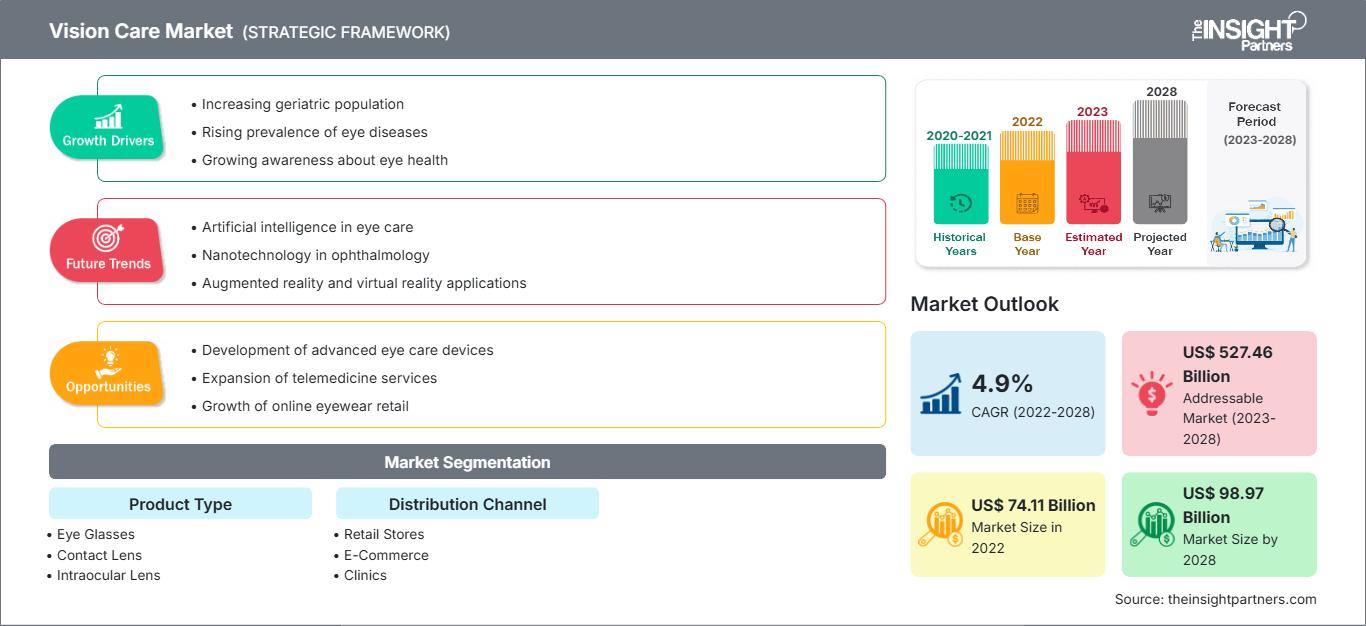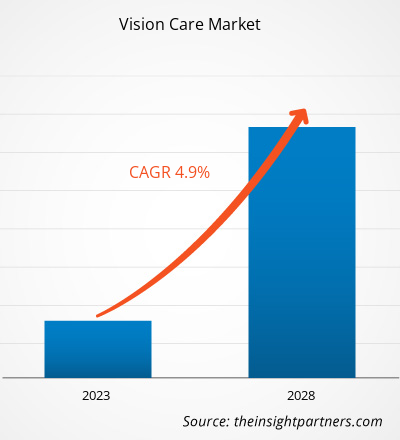Der Markt für Sehhilfen soll von 74.110,14 Millionen US-Dollar im Jahr 2022 auf 98.968,42 Millionen US-Dollar im Jahr 2028 wachsen; von 2022 bis 2028 wird eine durchschnittliche jährliche Wachstumsrate (CAGR) von 4,9 % erwartet.
Zu Sehhilfenprodukten gehören Brillen, Kontaktlinsen, Intraokularlinsen, Kontaktlinsenlösungen, Augentropfen und mehr. Die zunehmende Verbreitung von Augenerkrankungen fördert die Entwicklung fortschrittlicher Sehhilfenprodukte. Auch die steigende Zahl von Programmen zur Sensibilisierung für Sehhilfen fördert die weltweite Einführung von Sehhilfenprodukten.
Markteinblicke
Zunehmende Verbreitung von Augenkrankheiten treibt das Wachstum des Sehhilfenmarktes an
Weltweit sind zahlreiche Augenkrankheiten verbreitet, darunter Katarakte, Glaukom und Refraktionsfehler. Laut einem 2022 von der Weltgesundheitsorganisation (WHO) veröffentlichten Artikel leiden weltweit etwa 2,2 Milliarden Menschen an einer Sehbehinderung im Nah- oder Fernbereich. Die häufigsten Ursachen für Sehbehinderungen sind Katarakte (ca. 94 Millionen Fälle) und nicht korrigierte Brechungsfehler (ca. 88,4 Millionen Fälle). Weitere Ursachen für Sehbehinderungen sind Glaukom, Hornhauttrübungen, diabetische Retinopathie und Trachom mit jeweils ca. 7,7 Millionen, 4,2 Millionen, 3,9 Millionen und 2 Millionen Fällen. Laut Daten der Centers for Disease Control and Prevention (CDC) litten im Jahr 2022 in den USA etwa 12 Millionen Menschen im Alter von 40 Jahren und älter an einer Sehbehinderung, davon 3 Millionen nach Korrektur und 8 Millionen aufgrund eines nicht korrigierten Brechungsindex. Die zunehmende Zahl von Diabetes und anderen chronischen Erkrankungen ist für die hohe Prävalenz von Sehbehinderungen in der US-Bevölkerung verantwortlich. Laut den Ergebnissen der Canadian Health Measures Survey von 2016 bis 2019 gaben 50,4 % der Erwachsenen im Alter von 40 bis 64 Jahren und 71,6 % der Senioren im Alter von 65 bis 79 Jahren an, im vergangenen Jahr einen Augenarzt aufgesucht zu haben. Darüber hinaus lebten laut dem Royal National Institute of Blind People im Jahr 2021 in Großbritannien rund 2 Millionen Menschen mit Sehverlust. Im Jahr 2021 wurde die Zahl blinder oder teilweise blinder Menschen in Großbritannien mit rund 340.000 registriert. Laut Angaben der indischen Regierung wurden im Zeitraum 2021–2022 rund 5,7 Millionen Kataraktoperationen durchgeführt, im Zeitraum 2020–2021 waren es rund 3,6 Millionen.
Darüber hinaus unterstreichen die zunehmende Alterung der Bevölkerung und der Arbeitskräfte in verschiedenen Ländern sowie die gestiegenen Sehanforderungen moderner Berufe die Auswirkungen von Sehbehinderung und Blindheit auf die Wirtschaft. Daher fördert die hohe Prävalenz von Sehbehinderung und Blindheit in verschiedenen Teilen der Welt das Wachstum des Marktes für augenärztliche Versorgung.
Passen Sie diesen Bericht Ihren Anforderungen an
Sie erhalten kostenlos Anpassungen an jedem Bericht, einschließlich Teilen dieses Berichts oder einer Analyse auf Länderebene, eines Excel-Datenpakets sowie tolle Angebote und Rabatte für Start-ups und Universitäten.
Markt für Sehhilfen: Strategische Einblicke

-
Holen Sie sich die wichtigsten Markttrends aus diesem Bericht.Dieses KOSTENLOSE Beispiel umfasst Datenanalysen, die von Markttrends bis hin zu Schätzungen und Prognosen reichen.
Steigendes Bewusstsein für Augenpflege bietet zahlreiche Marktchancen
In den letzten Jahren wurden verschiedene Maßnahmen und Anstrengungen unternommen, um das Bewusstsein der Menschen zu schärfen und sie über Augenkrankheiten aufzuklären, damit Patienten Zugang zu geeigneten Medikamenten und Behandlungen für derartige Leiden erhalten. 2017 startete das National Eye Institute (NEI) in den USA „Write the Vision“, ein neues Aufklärungsprogramm zur Augengesundheit, speziell für afroamerikanische Verbraucher. Write the Vision bietet zahlreichen Organisationen monatlich Ressourcen, damit diese gesundes Sehen fördern und Sehverlust sowie Blindheit in den von ihnen betreuten Gemeinden vorbeugen können. Laut dem National Eye Health Education Program, einem Teil des NEI, sind Afroamerikaner anfälliger für Augenkrankheiten. Dies kann zu Sehverlust führen, wenn es nicht rechtzeitig behandelt wird. Daher wurde das Programm „Write the Vision“ ins Leben gerufen, um das Bewusstsein für Augengesundheit zu schärfen.
Sightsavers – eine internationale Nichtregierungsorganisation – arbeitet in Entwicklungsländern an der Behandlung und Vorbeugung von Augenkrankheiten. In Indien lebt ein großer Teil der Bevölkerung in ländlichen Gebieten und ist sich Augenkrankheiten kaum oder gar nicht bewusst. Sightsavers möchte mit seinem Programm für Augengesundheit im ländlichen Raum ein Bewusstsein dafür schaffen, qualitativ hochwertige augenmedizinische Dienste anbieten und vermeidbare Blindheit in der Landbevölkerung ausmerzen. Darüber hinaus hat die WHO die Veranstaltung „Universal Health Coverage and Eye Care: Promoting Country Action“ ins Leben gerufen, die praktische Schritt-für-Schritt-Anleitungen bietet, um die Mitgliedstaaten der WHO bei der Planung und Umsetzung der Empfehlungen des Weltberichts der WHO zum Thema Sehen zu unterstützen. Die WHO hat diese Veranstaltung mit dem Ziel ins Leben gerufen, integrierte, patientenorientierte augenmedizinische Dienste anzubieten. Die steigende Zahl solcher Programme zur Sensibilisierung für Augengesundheit schafft somit Wachstumschancen für den Markt für Sehhilfen.
Produkttypbasierte Erkenntnisse
Basierend auf dem Produkttyp ist der Markt für Sehhilfen in Brillen, Kontaktlinsen, Intraokularlinsen und andere Produkte unterteilt. Das Brillensegment hatte 2021 den größten Marktanteil und wird im Prognosezeitraum voraussichtlich die höchste durchschnittliche jährliche Wachstumsrate (CAGR) aufweisen.
Vertriebskanalbasierte Erkenntnisse
Basierend auf dem Vertriebskanal ist der Markt für Sehhilfen in Einzelhandelsgeschäfte, E-Commerce, Kliniken und Krankenhäuser unterteilt. Das Segment Einzelhandelsgeschäfte hatte 2021 den größten Marktanteil, und das E-Commerce-Segment wird im Prognosezeitraum voraussichtlich die höchste durchschnittliche jährliche Wachstumsrate (CAGR) von 9,5 % verzeichnen.
Markt für Sehhilfen
Die Analysten von The Insight Partners haben die regionalen Trends und Faktoren, die den Markt für Sehhilfen im Prognosezeitraum beeinflussen, ausführlich erläutert. In diesem Abschnitt werden auch die Marktsegmente und die geografische Lage in Nordamerika, Europa, dem asiatisch-pazifischen Raum, dem Nahen Osten und Afrika sowie Süd- und Mittelamerika erörtert.Umfang des Marktberichts zur Sehhilfe
| Berichtsattribut | Einzelheiten |
|---|---|
| Marktgröße in 2022 | US$ 74.11 Billion |
| Marktgröße nach 2028 | US$ 98.97 Billion |
| Globale CAGR (2022 - 2028) | 4.9% |
| Historische Daten | 2020-2021 |
| Prognosezeitraum | 2023-2028 |
| Abgedeckte Segmente |
By Produkttyp
|
| Abgedeckte Regionen und Länder |
Nordamerika
|
| Marktführer und wichtige Unternehmensprofile |
|
Dichte der Marktteilnehmer im Bereich der Augenheilkunde: Verständnis ihrer Auswirkungen auf die Geschäftsdynamik
Der Markt für Sehhilfen wächst rasant. Die steigende Nachfrage der Endverbraucher ist auf Faktoren wie veränderte Verbraucherpräferenzen, technologische Fortschritte und ein stärkeres Bewusstsein für die Produktvorteile zurückzuführen. Mit der steigenden Nachfrage erweitern Unternehmen ihr Angebot, entwickeln Innovationen, um den Bedürfnissen der Verbraucher gerecht zu werden, und nutzen neue Trends, was das Marktwachstum weiter ankurbelt.

- Holen Sie sich die Markt für Sehhilfen Übersicht der wichtigsten Akteure
Unternehmen im Markt für Augenheilkunde verfolgen anorganische und organische Strategien wie Fusionen und Übernahmen. Nachfolgend sind einige wichtige Marktentwicklungen der letzten Zeit aufgeführt:
- Im März 2022 brachte Alcon Inc. die IOL-Familie Clareon in den USA auf den Markt. Mithilfe des fortschrittlichsten IOL-Materials von Alcon kann Clareon konsistente Sehergebnisse und außergewöhnliche, anhaltende Klarheit liefern.
- Im Januar 2022 brachte Alcon die DAILIES TOTAL1 for Astigmatism auf den Markt, die erste und einzige Kontaktlinse mit Wassergradient für Patienten mit Astigmatismus.
- Im Juni 2022 erwarb CooperVision EnsEyes, einen führenden Anbieter von Orthokeratologie (Ortho-K) und Sklerallinsen in Skandinavien. Das Unternehmen wird Teil der Cooper Vision Specialty EyeCare-Gruppe.
- Im Februar 2021 übernahm Johnson & Johnson Vision Inc. erhielt die CE-Kennzeichnung für seine multifokale Kontaktlinse Acuvue Oasys mit pupillenoptimiertem Design für Europäer. Sie wird zur Behandlung von Patienten mit Presbyopie eingesetzt.
Firmenprofile
- Alcon Inc
- Bausch Health Companies Inc
- Carl Zeiss AG
- Cooper Companies Inc
- Essilorluxottica SA
- Johnson And Johnson Services Inc.
- Hoya Corporation
- Rodenstock Gmbh
- Menicon Co. Ltd
- Rayner Intraocular Lenses Limited
- Historische Analyse (2 Jahre), Basisjahr, Prognose (7 Jahre) mit CAGR
- PEST- und SWOT-Analyse
- Marktgröße Wert/Volumen – Global, Regional, Land
- Branchen- und Wettbewerbslandschaft
- Excel-Datensatz
Aktuelle Berichte
Erfahrungsberichte
Grund zum Kauf
- Fundierte Entscheidungsfindung
- Marktdynamik verstehen
- Wettbewerbsanalyse
- Kundeneinblicke
- Marktprognosen
- Risikominimierung
- Strategische Planung
- Investitionsbegründung
- Identifizierung neuer Märkte
- Verbesserung von Marketingstrategien
- Steigerung der Betriebseffizienz
- Anpassung an regulatorische Trends






















 Kostenlose Probe anfordern für - Markt für Sehhilfen
Kostenlose Probe anfordern für - Markt für Sehhilfen